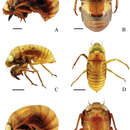紅脈熊蟬
(
Chinês
)
fornecido por wikipedia 中文维基百科
紅脈熊蟬: Brief Summary
(
Chinês
)
fornecido por wikipedia 中文维基百科
紅脈熊蟬(学名:Cryptotympana atrata),舊名「脈赤熊蟬」,中国大陆地区习惯称为“黑蚱蝉”。为蟬科熊蟬屬下的一个种,分布於中國大陸、印度北方、日本、韓國、臺灣西部平地之苦楝、構樹、柳樹、樟樹及菩提樹等,每年6至9月出沒,公蟬體長約37~40毫米(1.5~1.6英寸),母蟬約在36~39毫米(1.4~1.5英寸)。另外,正在吸食植物枝葉時,每次排泄量約0.2毫公升(0.0070英制液態盎司;0.0068美制液態盎司),每分鐘排泄次數約3至6次。
말매미
(
Coreano
)
fornecido por wikipedia 한국어 위키백과
말매미(Cryptotympana atrata)는 곤충강 노린재목 매미아목 매미과의 곤충이다. 대한민국에서 가장 큰 매미로, 몸길이는 44mm 내외이고, 날개까지 길이는 65mm 내외이다. 몸은 광택이 나는 검은색에 새로 나온 개체는 금빛 가루가 덮여 있으며, 배와 다리에는 주황색 무늬가 있다. 플라타너스, 버드나무 따위가 사는 낮은 지대의 벌판에 살며 성충은 6~10월에 활동한다. 한반도 전역에 서식하며, 세계적으로는 중국에 분포한다.[2][3]
울음소리
가로수에서 무리를 지어 울며, 밤에도 불빛이 있으면 합창을 한다. 울음소리는 무엇을 쏟아붓듯 ‘짜르르르···’하고 시끄럽게 운다. 주로 높은 가지에 앉아 한 마리가 울면 여러 마리가 경쟁적으로 동시에 소리를 낸다. 말매미는 주로 7월 중순~8월 하순에 매우 울어댄다.
중국의 말매미
중국에도 말매미가 분포하며 식용 및 약용으로도 이용된다.
일본의 말매미
일본에는 말매미속에 약 3종류가 있는데, 그 중 가장 대표적인 종류가 일본에서 곰매미(クマゼミ,Cryptotympana facialis)라며 부르는 종이다. 말매미(C. atrata)와 다르게 '시야-시야-'하고 울며 말매미보다 몸집이 더 크다. 일본에서는 말매미를 스지아카곰매미(スジアカクマゼミ)라고 부르는데, 2001년 일본에서 서식함이 확인되었으며 목재품과 같이 들어왔다고 한다.
![src=]()
일본의 곰매미(
Cryptotympana facialis)
각주
Description
(
Inglês
)
fornecido por Zookeys
Body (Fig. 2A, B) dark brown, curved in lateral view, with sparse setae mainly on venter.
Head (Fig. 2B). Somewhat triangular in dorsal view; crown including white compound eyes about four times wider than long and about the same width as anterior margin of pronotum. Antenna brown, filiform. Postclypeus prominently swollen, covered with dense brown pile. Rostrum reaching to posterior coxae.
Thorax (Fig. 2A, B). Pronotum broad, paramedian and lateral fissures distinct, pronotal collar undeveloped, posterior margin distinctively concave medially in dorsal view. Mesonotum slightly wider than pronotum, with two small scutal depressions on disc. Metanotum very small. Fore wing bud developed, reaching to middle of 3rd abdominal segment laterally; hind wing bud slightly developed.
Leg (Figs 5A, B, 6A, D). Generally dark brown. Fore femur with femoral formula 2-1-7: posterior tooth long and sharp, accessory tooth robust and sharp, intermediate tooth with projection in one of its sides; femoral comb usually with seven teeth, the first tooth about as large as the second tooth. Fore tibia arched, flattened laterally; apical tooth long; point of blade of tibia large and long, tooth-like, separated from apical tooth of blade by a strong incision. Apex of tibia with five spines in both mid and hind legs. Pretarsi of all legs well developed into a pair of claws of unequal sizes.
Abdomen (Fig. 4A–C). Size varying depends on the development of the nymph. In female, 8th and 9th sternites with two sharp posterior marginal protrusions. In male, 9th sternite almost entirely concealed by 10th sternite, four protrutions present on surface: a large triangular protrusion near lateral margins, respectively, and a pair of very small rounded protrusions on posterior margin; 10th sternite smooth.
- licença
- cc-by-3.0
- direitos autorais
- Zehai Hou, Qinglong Li, Cong Wei
- citação bibliográfica
- Hou Z, Li Q, Wei C (2014) Morphology and identification of the final instar nymphs of three cicadas (Hemiptera, Cicadidae) in Guanzhong Plain, China based on comparative morphometrics ZooKeys 425: 33–50
- autor
- Zehai Hou
- autor
- Qinglong Li
- autor
- Cong Wei

